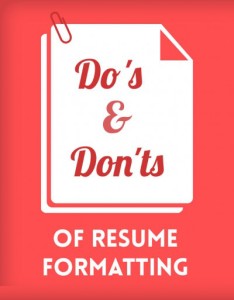 Clients often ask me how a resume should be formatted. (Note: this question doesn’t relate to resume types (e.g. chronological, functional, combination resumes), a subject which I will cover in a future blog post.)
Clients often ask me how a resume should be formatted. (Note: this question doesn’t relate to resume types (e.g. chronological, functional, combination resumes), a subject which I will cover in a future blog post.)
The question relates to how a resume should be laid out from a visual, style and design standpoint.
In other words, what design elements should a resume incorporate?
I would be lying if I said design plays no role in the creation of a resume; it does play a role, but it is a secondary one. The primary component of a resume is its content; it is the content that speaks to your background, education and skill sets. Design helps in the communication of that content. Design also helps the viewer interpret and internalize the words written on the page.
I always tell my clients not to be overly fussed with design and style, and to pay more attention to the composition of sentences, the grammar, the names and dates. That said, there are some basic style guidelines you should follow whenever creating a resume.
Essential Do’s and Don’ts for Formatting Your Resume
DO:
- Use bullet points whenever you need to itemize things such as job duties, awards and scholarships, certificates, etc.
- Leave some negative space between each section of your resume. (Negative space means any blank areas.) Negative space helps the viewer read the sentences in your resume. Any document – especially a resume – with text that’s crammed together is difficult to read.
- Use standard, business fonts such as Times New Roman or Arial. Use Comic Sans font only if you want your resume sent to the paper shredder.
- Use font size 10, 11 or 12. If you wish to emphasize headings and titles, you may use font size 14 or 16.
- Use no more than two different font sizes in your resume.
- Use bold fonts sparingly, and only to highlight key items such as the names of companies, job titles, or degrees. Some people use bold fonts to highlight key skills and qualifications, and that’s fine. Remember that bold fonts are only used to draw the reader’s attention to certain areas; no more than 10 per cent of your resume should be bolded.
- Use italicized fonts only if you are referring to the names of books or magazines (which presumably contain work you’ve authored).
- Stick to standard page margins of about one-inch at the top and bottom, and at the right and left sides. (This is the approximate default margin found in Microsoft Word.)
DON’T:
- Use any type of watermark, or incorporate graphic vectors, logos, emblems or images onto your resume. The only thing that should be in your resume is text.
- Use any colour other than black. (If you are applying for a creative or artistic position, then the use of a colour other than black might be called for. The design guidelines here apply to all non-artistic roles.)
- Use underlined fonts if you are bolding words. Choose underlined or bolded fonts, but not both.
- Affix an image of yourself. In certain parts of the world, such as Europe, it may be customary to do so, but not here in Canada.
- As far as graphics are concerned, you may use a heavy weighted line to divide sections of your resume. I prefer to use solid lines rather than dashed lines. A 6 pt. line is as thick as you want to go, and try not to use more than two different pt. sizes for your lines.
These guidelines aren’t set in stone. When in doubt, err on the side of caution, and keep your resume conservative in design and lay out. The whole purpose of design is to aid the reader in viewing your resume. Unless you’re applying for a creative or artistic job, focus your energy on sentence structure, grammar and the elimination of typos.
Create the resume you use for BCjobs.ca with Milton Kiang, B.A., LL.B. at Channel Resume!
Tags: career advice



